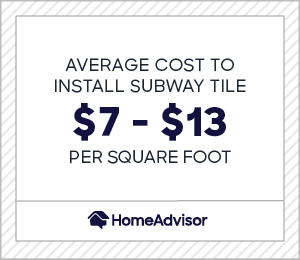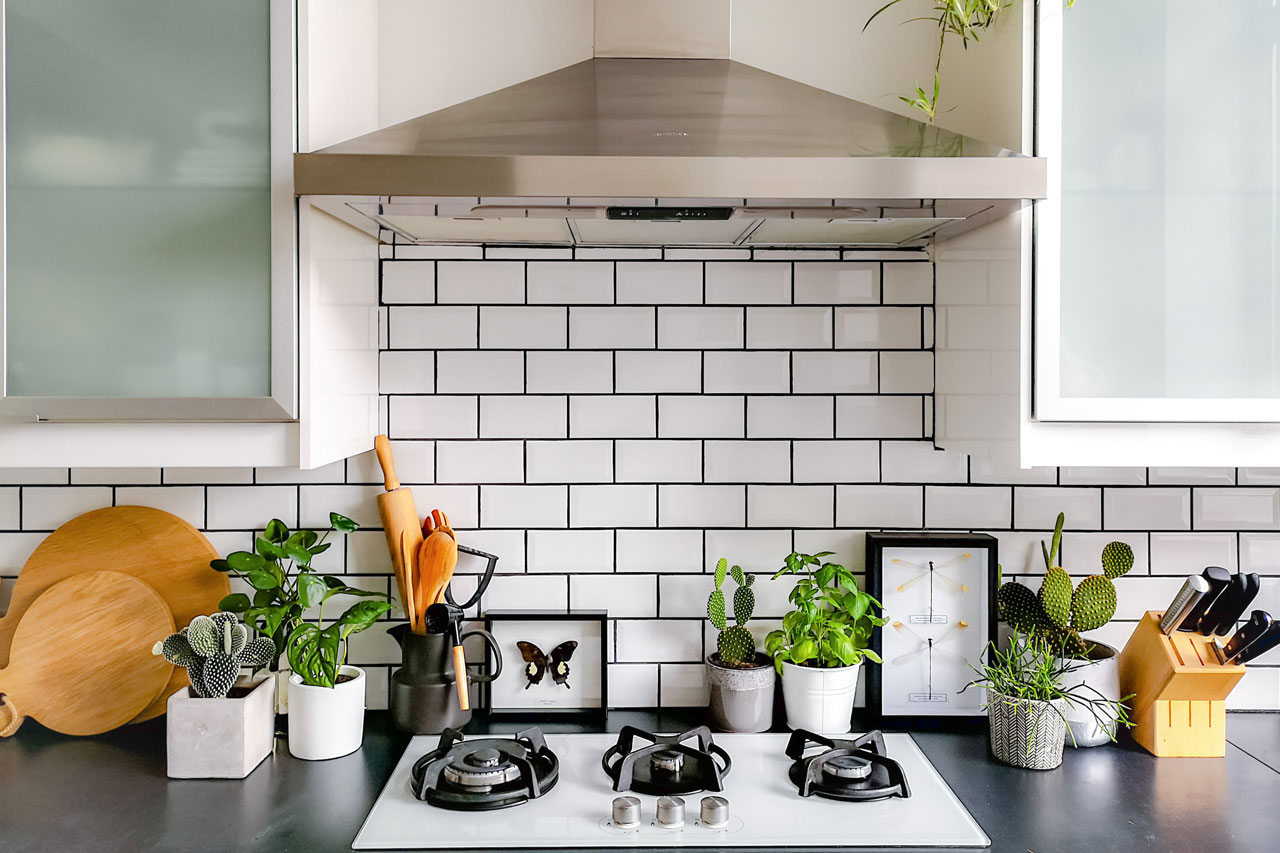How Much Does Subway Tile Cost per Square Foot?
Typical Range:
$7 - $13
Typical Range:
$7 - $13
Cost data is based on research by HomeAdvisor.
On average, subway tile costs anywhere from $7 to $13 per square foot. At the highest, you could pay around $24 per square foot, as compared to $1.20 per square foot at the lowest.
Subway tile can take your space from bland to beautiful, whether it’s installed in a kitchen, bathroom, or shower. Before you attempt a DIY tile job or hire a professional, however, it helps to know how much subway tile costs.
2022 Notice: Material Prices Are Surging
Demand for siding and other building materials has grown over the past year. And as a result, manufacturers are increasing materials prices. Prices have gone up 5% to 10% this year, and many parts of the country are experiencing long delivery times. If you're planning a building project, we recommend starting as early as possible in the season, preparing for potential price fluctuations, and allowing extra time to order materials.
A basic 3-inch-by-6-inch ceramic subway tile can cost as little as $1.20 per square foot or as much as $24 per square foot. In general, however, you should be prepared to spend between $7 and $13 per square foot.
This doesn’t include the cost of grout, sealant, or any additional tools or materials, such as backer board or a tile cutter. While subway tile prices can be fairly budget-friendly, things can add up once you factor in other materials and labor.
Whether you’re redoing your kitchen with a vibrant blue backsplash or want to line your shower walls with classic white subway tile, here’s a look at what you’ll pay.
The cost to install a subway tile backsplash in your kitchen could be between $1,300 to $2,400. This depends on the square footage of your backsplash and whether you take the tile all the way up the wall or just between your countertop and cabinets.
A classic white subway tile can match just about any kitchen style, while a marble or herringbone-patterned subway tile brings a more modern touch.
Regardless, the average subway tile installation cost is about $1,000, so it’s a good idea to have at least that price point in mind when budgeting for this type of project.
For basic bathroom wall tiles, you’ll pay around $1.50 to $2 per square foot, as opposed to more intricate designs, which cost around $4 to $6 per square foot. Although this subway tile price is on the lower end of the spectrum, you will likely need more of it since your bathroom walls probably take up more space than a shower or backsplash.
The cost to install shower tile ranges anywhere from $450 to $10,000, which includes the price you’ll pay for tile, materials, and installation. The type of shower you’re tiling can also make a difference. Walk-in showers, for example, cost $2,500 to $5,000 to tile, depending on the size of the space and the difficulty of the job.
Labor charges on top of subway tile costs can alter the total amount you spend by a significant amount if the tile is hard to cut or has to be placed around several obstacles, such as windows, outlets, or other barriers. Contractors typically charge an hourly fee plus a difficulty fee that can fall anywhere from $600 to $1,350.
From backsplashes to walls, what you’ll pay for your home improvement project greatly depends on the square footage.
Subway tile comes in a variety of sizes—some as small as 2-by-4-inches or as large as 12–by-24-inches. The size you prefer to install can determine whether you go over or under budget. Here’s an idea of what the range of sizes costs per 10 square feet.
| Tile Size | Average Price per 10 Square Feet |
|---|---|
| 3-by-6 | $55 |
| 4-by-4 | $60 |
| 4-by-8 | $66 |
| 4-by-12 | $70 |
| 2-by-4 | $70 |
| 2-by-8 | $75 |
| 4-by-10 | $90 |
| 12-by-24 | $110 |
| 3-by-12 | $180 |
Ceramic subway tile is the most budget-friendly material on the market, while marble and granite are traditionally the most expensive. However, “porcelain tile is the most durable, and its price can be at times as low as ceramic,” says Ezra Laniado, Angi Expert Review Board member and owner of Landmark Construction & Development Group, Inc. The type of material you choose for your subway tile can make a major difference in what you end up paying.
The cost to install ceramic or porcelain tile, for example, can be as high as $115 per square foot.
| Tile Material | Average Price per Square Foot |
|---|---|
| Ceramic | $5 – $10 |
| Porcelain | $5 – $10 |
| Travertine | $20 – $30 |
| Glass | $30 – $40 |
| Copper | $30 – $50 |
| Steel | $30 – $40 |
| Granite | $35 – $60 |
| Marble | $40 – $50 |
If you have some DIY experience, you might consider taking on this job yourself. However, to ensure installation goes smoothly and you get the exact look you want, it would be best to hire a pro.
If you or your tile installer has to account for the cost to repair previous tile and grout, it could significantly increase the total budget for installation. The difficulty of the job is also something to consider, as labor costs could increase when contractors have to tile in intricate patterns or around tricky corners or uneven walls.
The average cost to hire a professional to install subway tile backsplash is $40 to $150 per hour, minus the materials. Simple, straightforward subway tile falls on the lower end of labor costs, while a more complex design or level of difficulty falls on the higher end.
To complete the project yourself, you’ll likely spend about $300 on tools and materials, depending on the square footage of the area you’re tiling.
This task requires lengthy preparation, especially if you’re a novice DIYer. You’ll need to properly remove existing tile, sand the walls, tape off surrounding surfaces, and detach outlet covers. If you don’t have spare time to devote to tiling, find a local tile installer who can get it done in a pinch.
The easiest way to get the best deals on subway tiles is to compare prices on various sites. You can also get more accurate estimates by contacting a tile backsplash contractor near you who can give you a professional quote.
The classic subway tile size is 3-by-6 inches,but you can find them in a wide variety of lengths and widths. For a timeless look in a kitchen backsplash, you can use 3-by-6 inches or 4-by-4 inches in a straight-set pattern. Other options include 3-by-12 inches, 4-by-10 inches, 2-by-8 inches, 4-by-12 inches, and 12-by-24 inches.
Yes. Although you can lay subway tile in a variety of patterns, herringbone can cost up to $2 to $4 more per square foot for labor due to the complexity of the style.
Herringbone requires more intricate cuts and more attention to detail, especially since most walls aren’t perfectly perpendicular or square. This style can create a beautiful focal point or accent wall, but be prepared to pay more for it.
To properly clean subway tiles, you’ll need a mixture of distilled vinegar and dish soap. Combine about 6 teaspoons of the vinegar with a few drops of dish soap and spray your subway tile thoroughly. Let the solution sit for 2 to 3 minutes before wiping off with a damp washcloth and drying with a clean towel.
First, determine which walls you want to install the tile on. Then, multiply the length and width of each wall and add an extra 20% to account for breakage or mistakes. This will ensure you have enough material to get the tiling done without multiple trips to the hardware or tile store.
Subway tile got its name because it was the material first used in New York subways in the 1900s. Since then, it’s grown in popularity because it’s easy to clean and comes in a variety of shapes, sizes, and styles.

